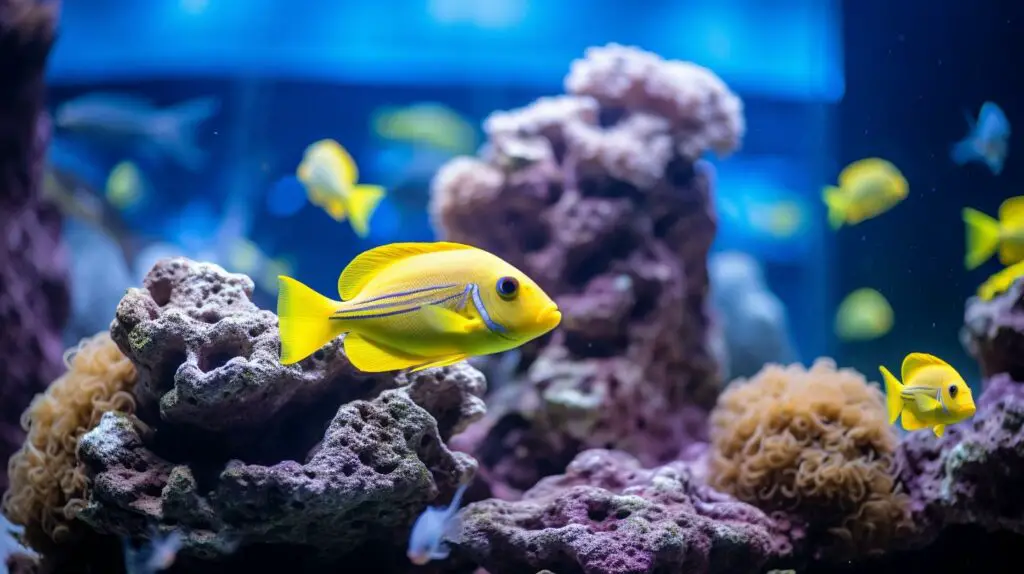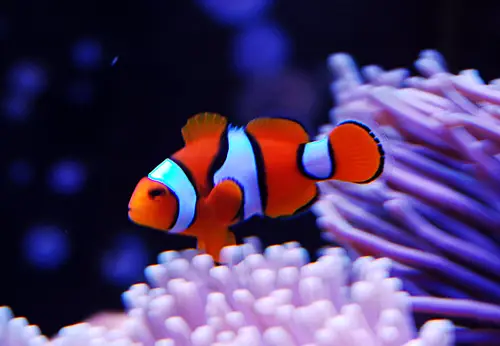Have you ever seen a fish swimming backward? I’m sure, right now, you must be rewinding your mind and imagining a fish swimming, right? Like you when I first started researching this topic, I couldn’t think of any backward swimming fish. So can fish swim backward actually?
Yes, most bony fish and some cartilaginous fish can swim backward. In fact, Eels, triggerfish, carp, black ghost knife fish, Opah fish, and blue gill sunfish can swim backward really well. But swimming in backward direction needs extra energy and strength. And on top of that, the process is totally different from fish’s regular swimming style. So, without absolutely necessary, for instance, escaping from any predator or exploring new territories, fish does not try reverse swimming.
In the rest of the article, I’ve discussed how fish swim backward, what fish can swim backward, why they even do this and much more. Exciting, right? So stay tuned till the end and learn some surprising facts about one of the fascinating creatures fish!

How Fish Swim Backwards?
Before going there, let’s see how all species of fish swim normally. This will help you to understand the science of fish’s reverse swimming well.
Fish swims in the water with the help of their fins and muscles. A fish has a total of 6 types of fins. Each of them has different functions. The dorsal fin and the anal fin help the fish to keep its balance in the water. The caudal fin is used like a motor that pushes the fish forward and helps it to move around. Finally, the Pectoral and pelvic fins help the fish to swim up and down and turn from left to right or right to left.
Most fish swims in the water by propelling themselves by moving their fins, tails and body in S-shaved waves. Such curve-shaped waves thrust the fish forward. Here the pectoral and pelvic fins do most of the work.
When a fish needs to swim backward, the two pelvic fins slow down swimming movement while the two pectoral fins move in the opposite direction which allows the fish to go backward. Here the tail does most of the work.
But for eel-like fish, the process is quite simple. They just reverse the direction of the muscle contractions and go backward.
The ability to move backward is called “Paddle-Back”. This behavior was first observed in the early 1900s when scientists noticed that some species of fish were able to turn around and go back upstream against the current.
Do All Fish Have the Ability to Swim Backwards?
Swimming is an essential survival skill for fish, enabling them to hunt, avoid predators, and navigate their underwater world. The agility and speed of a fish are heavily influenced by its physical design and the environment it inhabits.
Fish locomotion primarily relies on the caudal (tail) fin and the body’s flexible, undulating movements. As fish propel themselves through the water, most of the movement occurs in the posterior body and tail, which work as a single unit.

Interestingly, while many fish can move backward by using their pectoral fins, true backward swimming—propulsion via undulation of the body and tail, but in reverse—poses a much greater challenge. Biologically, most fish are not equipped for this movement as it requires reversing the wave of muscle contraction, a complex feat few species have mastered.
It’s a fascinating, yet largely underexplored, fact that not all fish can swim backwards. While species like eels, moonfish, and triggerfish are capable of reverse movement, others like the great white shark cannot, as their pectoral fins are not as flexible or mobile.
What Fish Swim Backwards Well?
Although it seems very surprising, most fish can indeed swim backward. But it is for a very short time maybe for a few seconds.
Tuna, catfish, swordfish, sailfish, some mackerel and other marlins find it very difficult to swim backward. It’s because their pectoral fins are rigid and slender. But they manage to swim backward for a short time.
However, as always and everywhere, there are, of course, exceptions. Some fish species can swim backward really well.
Here is a list of fish that has been seen swimming backward:
1. Eels
Eels can move both forwards and backward thanks effortlessly because of their flexible body structure and strong caudal fin. As their tail and caudal fins are highly flexible, they can move those in any pattern and generate the necessary force to swim backward.

When an eel needs to swim backward, its muscles push the water backward, and its tail coordinates with them.
2. Triggerfish
Triggerfish have been seen swimming backward several times. When they want to swim backward, they use their dorsal and pectoral fins.
With pectoral fins, they push the water backward while the dorsal fin stabilizes their movement. The caudal fin also helps them to generate additional push to swim backward.
3. Black Ghost Knife Fish
The black ghost knife fish is one of the most interesting and unique freshwater species. Their eyesight is not well developed, so they hunt and communicate through an electric field.

Though they don’t have any dorsal or caudal fin, they have an underside long fin that starts just half an inch from the head to tail. They can swim forwards, backward or in any other direction through this fin. Their reverse swimming is quite well, which makes them unique from other fish species.
4. Blue Gill Sunfish
Bluegill sunfish is another good reverse swimming fish. The reverse movement of the dorsal and anal fins pushes them backward. The pectoral and caudal fins stabilize their balance and control their movement.
However, in this way, they can’t swim as fast as forward.
5. Opah Fish
Opahs are also known as moonfish or kingfish. They are found in the Pacific Ocean at a depth of 50 to 500 m.
Because of their habitat, not much research has been done on them. But according to recent research statistics, their body structure is perfect for both forward and backward swimming. But it is not yet known whether they can swim backward for a long time or not.
6. Carp
When it comes to swimming abilities, carps are incredible. They can swim in various directions forward, backward, sideways, up and down and even in circles.
When a carp needs to go backward, it uses its tail and two pectoral fins. The pectoral fins move in the opposite direction, just like we do during backstroke. The tail supports through moving side to side and creating waves.
But obviously, we can’t expect that graceful, speedy and powerful movement that we see in forward swimming. As reverse swimming is not a carp’s natural swimming position, they can’t do it for a long time.
7. Frontosa Cichlids/Cyphotilapia Frontosa
Frontosa cichlid is an east African fish species. They have a long fin just upside their spinal cord. This helps them in controlling their movement. When they want to go backward, they use their pectoral fins just like other reverse swimming fish does.

8. Seahorses
Seahorses, belonging to the genus Hippocampus, are well-known for their unique ability to swim backwards. They swim in an upright position, propelling themselves forward by fluttering their dorsal fin as many as 35 times per second.
When they need to swim backwards, they can simply reverse the motion. Seahorses primarily use this ability to adjust their position while feeding and to evade predators.
9. Pipefish
Pipefish are closely related to seahorses and share many of their unique characteristics, including the ability to swim backwards. They achieve this through an undulating, wave-like motion of their long, slender bodies.

Studies, such as one published in The Journal of Experimental Biology, suggest that this unique swimming style allows them to navigate complex environments and evade predators more effectively.
10. Gobies
Gobies, such as the Neon Goby (Elacatinus oceanops), have been observed to swim backwards as a means of quickly escaping threats. Their small size and fast reflexes, combined with the ability to swiftly move in reverse, make them adept at evading predators in their coral reef habitats.
Aquarium Fish That Can Swim Backwards
Aquarists always look for fish that have unique and fascinating characteristics. Adding some reverse swimming fish would undoubtedly be a great addition to any aquarium.
Let’s see some popular aquarium fish that can swim backward:
1. Clown Fish
Clownfish are also known as anemone fish. They are known for their incredible acrobatics, vivid colors and diverse swimming pattern, including backward swimming. They are good aquarium fish. Even after keeping clownfish for a long time, many aquarists never noticed their reverse swimming.

Surprisingly clownfish can swim both forward and backward with ease and grace. Their asymmetrical tail makes it easier to swim against natural law.
2. Betta
Betta are popular aquarium fish. They are known for their vibrant colors and aggressive behavior. If you place some of them together, you will see their invasive reaction. However, these fish can swim backward.
3. Goldfish
Goldfish can swim backward but, like other aquarium fish, not for a long time. They can do it for a few seconds only. With the help of pectoral and pelvic fins, goldfish swim backward.
4. Kuhli Loach
Kuhlis can swim backward. They are known for their eel-like body structure. These beginner-friendly fish are playful and peaceful. So they can be added to any community tank without any worries.
5. Guppies
Guppies are also known as million or rainbow fish. Guppies are one of the popular choices for newbie aquarists because of their incredible colors, easy maintenance and ease of breeding.
But most beginner does not know another fascinating characteristic of guppies is that they can swim backward. They don’t show it often because it requires a lot of energy.
6. Neon Tetra
This fish is widely known for its playful behaviors and bright colors. Neon Tetra is capable of reverse swimming. This helps them to escape from predators or navigate through tight spaces.
Why Do Fish Swim Backward?
Backward swimming for a long time is not good for any fish as it is totally opposite to their natural swimming position. Besides, it takes extra energy and strength than forward swimming. So why do fish do this?
There are several reasons for backward swimming. The most common reason is to escape from predators. They even do it during chasing prey or exploring new territory.

Let’s see why fish go against their natural swimming tactics.
1. Escape From Predators
The main purpose of fish’s backward swimming is to escape from predators. When any predator attacks from the front, the fish swims backward and hides behind trees, rocks or in any safe place.
2. Exploration Of New Territories
Fish that can swim backward have been noticed to use their skill while exploring new territories. Most of the fish are territorial. So while exploring new territories, they will check every in and out of that area by swimming in every direction.
When fish navigate in tight spaces like small tunnels, they swim in reverse. Because after going through the tunnel, they won’t have enough room to turn around and come back to the front. In such a situation, fish needs to use their reverse swimming skill.
4. Catching Prey
Backward swimming fishes often make a sudden attack and surprise the prey. This way they can catch the prey easily.
5. Mating And Breeding Behavior
When fish becomes mature enough for breeding, they are seen doing different acrobatics including backward swimming.
Can Fish Swim Backwards For Long?
Without eels and Kuhlis, no fish species can swim backward for a long time.
See, forward swimming is the natural swimming movement of every fish. Their body is structured according to that. While swimming they take oxygenated water through the mouth and take it out through branchia or gill. Thus their lung and breathing process works.
When they want to against nature’s laws and swim backward their body can’t support them for an extended time. While backward swimming they can’t take enough oxygenated water. So due to lack of oxygen, they may even die.
As fish can’t swim backward for a long time, they can’t go far through reverse swimming. Smaller fish can go only a few feet swimming backward. But because of the advantage of the length, large fish species can cover long distances.
What Fish Can’t Swim Backwards?
Many species of fish have difficulty swimming backwards or cannot do so at all. One prominent example is the shark. Sharks, such as the Great White Shark, cannot swim backwards due to their rigid pectoral fins and the fact that their bodies are designed to move forwards. In addition, sharks need to keep moving forward to push water over their gills to breathe.
Most species of fast-swimming fish like tunas and swordfish also have difficulty swimming backward because their bodies are highly streamlined for forward motion.
Fish with their bodies structured around a propulsive tail and undulating body motion, such as trout and salmon, are also poor at backward swimming as reversing this wave of movement is biomechanically difficult for them.
In order to swim backward, it requires enough strength and, most importantly favorable body structure like a strong tail and flexible fins. Evaluation is also a considerable factor here. Some species have been evaluated according to surrounding conditions and adopted the ability to swim backward.
But other fish species are following the natural swimming process. Here are some fish that hasn’t been observed to swim backward.
- Shark
- Marlin
- Razorfish
- Arowana
- Swordfish
- Tuna
- Salmon
- Trout
- Mackerel
- Barracuda
The list doesn’t end here because there are more species that haven’t been researched or observed. If scientists continue researching, more species will come to light.
Wrap Up
Some fish species can swim backward. Eels, triggerfish, carp, black ghost knife fish, Opah fish, and blue gill sunfish are examples of fish that can swim backward really well.
Again some aquarium fish have been observed to swim backward. They are clownfish, goldfish, beta, guppies, neon tetra, Kuhlis, etc.
There must be more fish species with reverse swimming ability. It just needs more research and observation to discover them.
However, swimming in a backward direction for a long time is not good for any fish. Their body structure and function of the organ are designed for forward swimming. If they try against the law of nature and swim backward for a long time, they may even die because of suffocation.
Fish has been observed to attempt backward swimming while escaping from predators, exploring new territories, navigating in tight spaces and catching prey. Some species have also been seen to do this during mating seasons.
Moreover, some fish, like sharks, seahorses, marlins, razorfish, arowana, etc, can’t swim backward.
